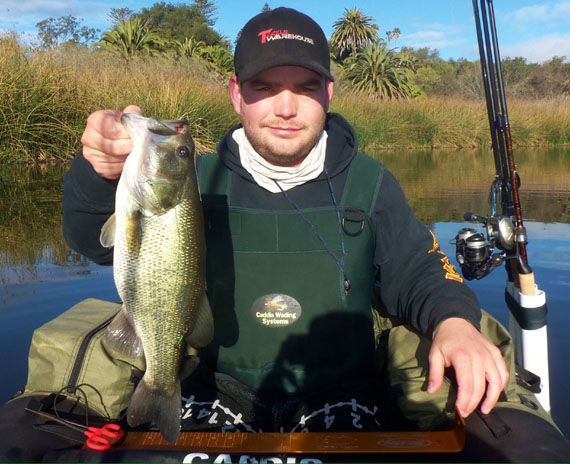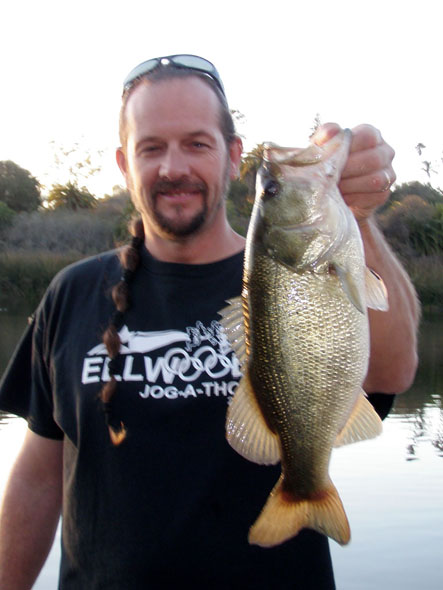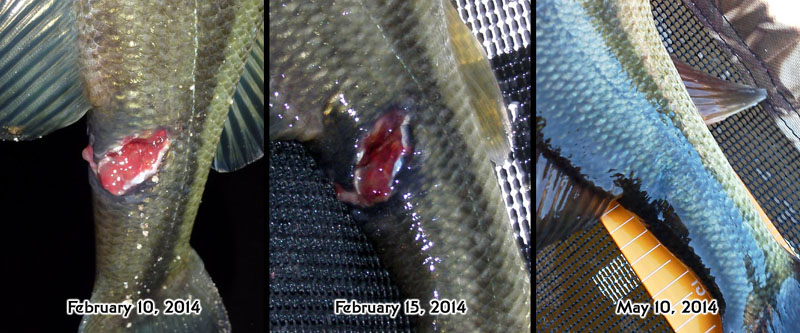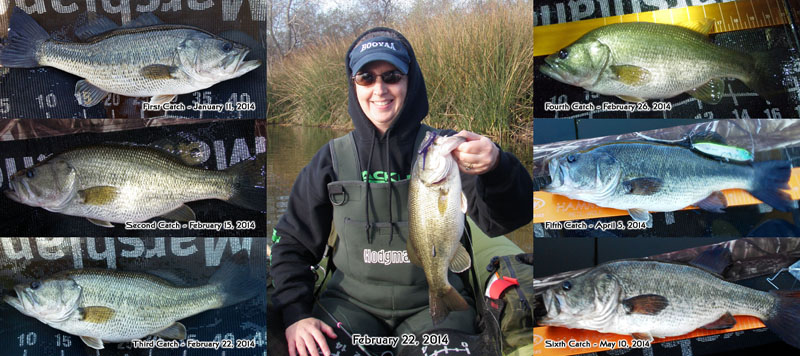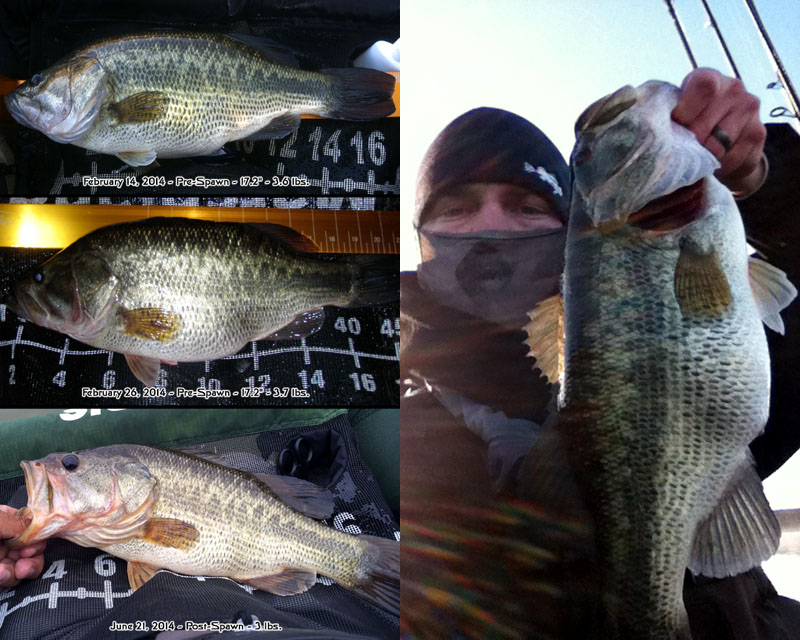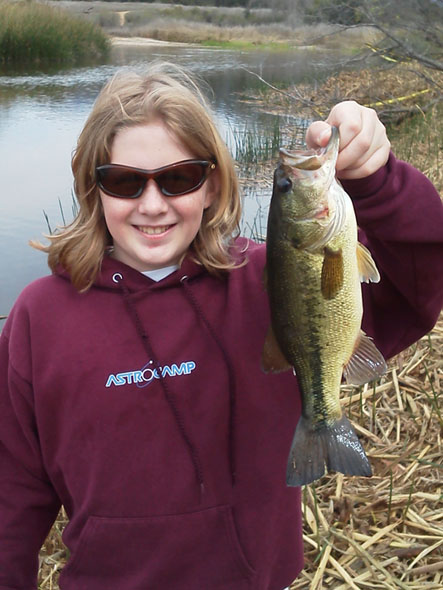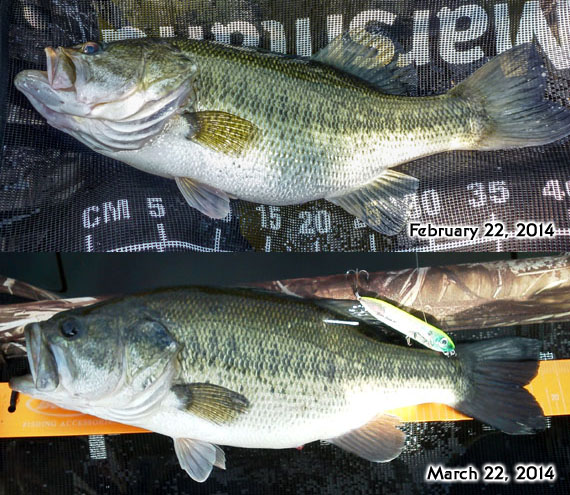
Tap here to skip introduction below and go
straight to the data
(data website not designed for small screens - best viewed
with a computer and monitor)
I began bass fishing at Lake Los Carneros in 1983 and quickly fell in love with the lake. For the next 10 years I kept a diary of every trip and every fish. For me it was much more than just catching fish... more than finding that perfect spot, picking the right lure, making that perfect cast and convincing a fish that the lure I picked is food. I wanted to know more... How big do they get? How fast do they grow? How many are there? Which ones are males and which ones are females? Do some move around more than others? If so, why? How soon will they eat again after being caught and released? How much weight does a female gain and lose during spawning season? These are just a handful of the many questions I have about the fish and this beautiful little lake they live in.
My curiosity lead to a short lived research project in the late 90s but it wasn't the right time for me to give a study the dedication it needed. Over the next decade or so I would fish the lake occasionally but it wasn't until the Fall of 2010, when my kids and I started fishing it again on a regular basis, that the time was right for a study that would help answer some of my questions.
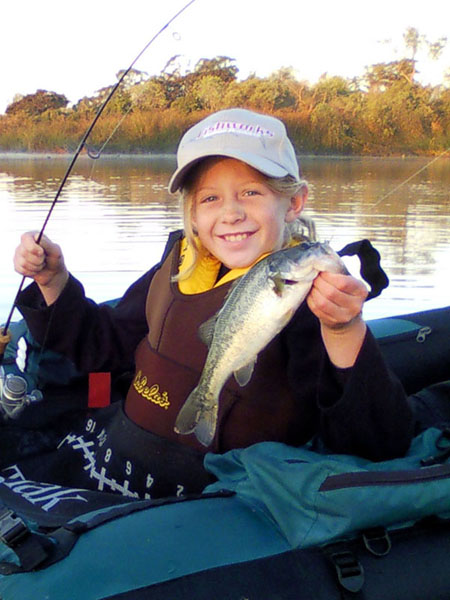
Pierce - September 2010
The Winter of 2010-2011 brought over 30 inches of rain to the Goleta Valley (average is ~18"). In 2011 the lake was full and healthy. On June 10th while fishing from shore with my kids near the spillway I hooked two bass on the same lure. The kids watched the whole thing. The first fish was on while the second fish was trying to steal the lure out of it's mouth... which lead to the second fish getting hooked as well. Eventually the second fish came off and I landed the first one. Shortly after I released it my daughter Sara asks me, "Daddy, have you ever caught the same fish twice in one day?". Her question inspired me to start another research project at Lake Los Carneros. A project that would eventually become my most extensive to date.
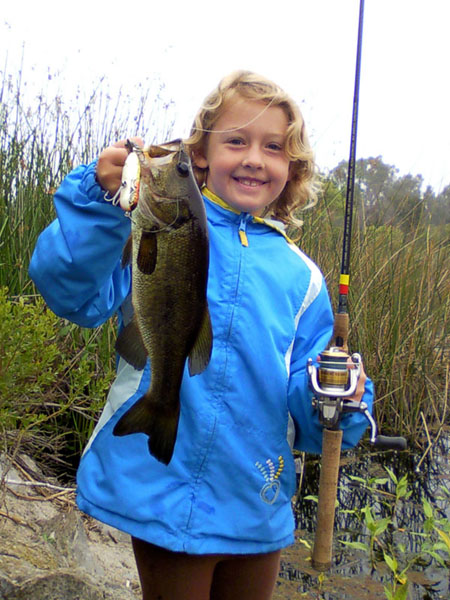
Sara - June 2011
Unfortunately the Winter of 2011-2012 only brought about 13½ inches of rain (~4½ inches below average) and like many times before during years of below average rainfall the lake suffered a large fish kill in the Fall of 2012. At the time we had caught and released 138 twelve inch or larger (12"+) bass out of an estimated population of ~800. These 138 bass were caught and released 178 times between June 12, 2011 and October 26, 2012. Sara, my friend Bryan and I examined the fish kill. We found approximately 143 dead 12"+ bass, at least 100 smaller bass, even more bluegill and one bullhead (catfish).
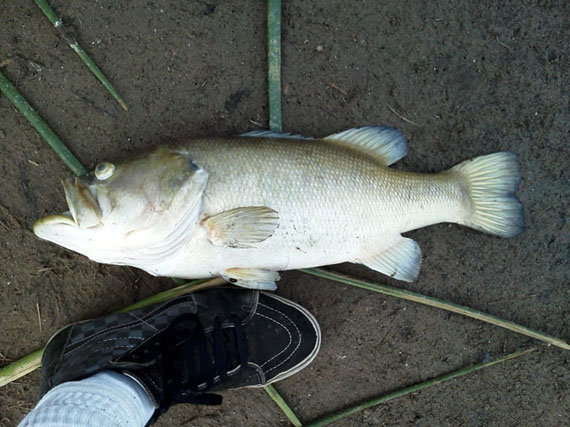
Fish Kill - November 1, 2012
As I have with each of the fish kills I have seen over the years I couldn't help but wonder... "Did all the fish die?" Thankfully as future data would show only about half of the 12"+ bass were killed during the 2012 fish kill. Five days after we examined the fish kill I walked over to the North Point and caught a 12" bass. Three days later I did it again... same lure, same area. Both fish were caught and released multiple times over the next year and a half and based on their growth rates both fish were females.
A couple of weeks later during Thanksgiving a group of us walked over to the lake. Fishing from shore I caught one of the bass we had caught prior to the fish kill. Knowing at least one of the bass we had caught and released prior to the 2012 fish kill was still alive inspired me to take our current "Have you ever caught the same fish in the same day?" research project to the next level... a detailed 20 month study of 274 bass (12"+) caught and released 743 times.
Below are some of my favorite fish caught during the study and what we learned from them. Click on the links for more detailed information about a particular fish or a particular day or... CLICK HERE to go directly to the home page of the study.
Fish #279 - How soon will a bass eat again after it has been caught and released?
The fish that answered Sara's original question a year and seven months after she asked it. Bryan and I caught a unique shaped 20" bass (3.4 lbs.) three times on February 24, 2013. The first two catches were 12 minutes apart. The fish was caught an additional four times between March and July 2013 making it the first fish we had caught and released seven times. Eight months later while fishing with my nephew Ryan I caught the fish again (April 12, 2014). As soon as I pulled it out of the water and saw it's unique shape I said to Ryan, "This looks like number 279"... and it was. It had gained about a half an inch and about a pound. It looked very healthy except for a quite severe wound on it's lower jaw. I believe this fish was the longest bass in the lake during the study.
Growth & Size:
Example 1 - male vs. female
and female growth rate:
Fish #273 and
#274 were originally
caught December 1, 2012
and re-caught February 14,
2014. In December 2012 they were both about 12" long and probably just under
a pound. In February 2014
#273 had grown an inch and a half and probably about a half a pound, while #274 grew about 2.5
inches and nearly tripled it's weight. Showing that #273 is most likely a
male and #274 is most
likely a female. #274 is
one of many examples of a ~12" female bass in Lake Los Carneros growing to
~16" in a little over a year.
Example 2 - female growth
rate:
#271 and
#272 (mentioned above in
the introduction) were the first and
second fish caught after the 2012 fish kill. Same lure, same area, three days
apart. As future catches would show both fish were most likely females. Two more examples of a ~12" female growing to ~16" in a little over a
year.
Example 3 - female growth
rate:
Fish #230 and
#268 were two small
females that were originally caught before the 2012 fish kill. Both
were caught again on January
12, 2014 - both fat pre-spawn 16" fish weighing in at around 3 pounds. Two
more examples of a ~12" female growing to ~16" in a little over a year.
Example 4 - female growth
rate:
Fish #294 was a ~13½"
fish originally
caught on May 10, 2013. Nine
months later (February 14,
2014) she was caught for the second time and had grown nearly 2½ inches. She
was caught again about a week later and once more on
May 26, 2014. Her post-spawn
weight dropped from 3.10 lbs. in February to 2.53 lbs. in May.
Example 5 - female growth
rate:
Another 2012 fish kill survivor, fish
#254 was originally
caught a couple months before the 2012 fish kill. Length was 12.7", weight was
1.14 lbs. Caught her again over 15 months later (December
13, 2013) during a quick trip fishing from shore with Sara. I didn't have my
ruler or scale with me. Estimated her length at 16". Another example of a ~12"
female growing to ~16" in a little over a year. One of my favorite fish of the
study. She was caught three more times in February 2014, then twice again in
April.
Heaviest bass in the lake
during the study:
Fish #365 was the first
4+ pound fish we caught after the 2012 fish kill. First catch was on
October 27, 2013. Second
catch was December 15, 2013.
Second catch was at the structure between Dam Point & Purgatory Cove - very
shallow. I believe this fish was the heaviest bass in the lake during the study.
Survival:
Surviving the catch -
probability over 97%:
96 bass (12"+) were caught and released during what I consider to be the 3
month "peak" of the study (November 2013 through January 2014). 87 of these 96
bass were caught at least twice or were found dead after one of the 2014 fish
kills. Proving at least 91% (and most likely over 97%) of the 12"+ bass caught during this period survived
at least the first catch and release. In addition, these same 96 bass were
caught and released a total of 298 times before the end of the study (2014 fish
kills).
Fish #235 (mentioned above in the introduction) was the first fish caught after the 2012 fish kill that we had caught and released at least once prior to the fish kill. This particular fish was one that at the time of the first catch (July 28, 2012) I questioned whether it would survive or not. It was hooked in the gill and bleeding quite badly. But, we released it anyway and about a month later it was caught again. On November 25, 2012 it was caught a third time and became the first "known survivor" of the 2012 fish kill and a testament to how tough bass can be. #235 was caught and released twice more in 2013.
Fish #333 was an example of how the bass can heal after a severe injury. Originally caught August 25, 2013, then again on January 11, 2014. A typical 12.5" fish. On February 10, 2014 it was caught again but this time it had a very severe, deep, wound on it's back right behind the dorsal fin most likely caused by a bird trying to eat it. It was caught again 5 days later - wound looked the same. A little under 3 months later it was caught again and the wound was completely healed.
Fish #443 was caught for the first time on January 11, 2014. It had a small hook lodged in it's throat which I removed. No blood or noticeable damage. The fish was caught and released 5 more times before I found it dead after the fish kill on July 20, 2014.
My friend Fred caught and released fish #439 three times between January and March of 2014. The second time it was caught an old hook was removed from it's throat.
Spawning:
Pre-spawn
behavior as the full moon approaches:
Several days before the full moon in January 2014 the scattered fish we had
been catching started stacking up mostly near Island Point. As the full moon
approached the fish moved from the deeper water off of island point to the
shallow water of the ledge/South East Cove.
January 11 -
January 12 -
January 13 -
January 14
Fish #400 was first caught on December 15, 2013 "offshore" in the North section of the lake. She was caught four more times in the Spring between January 13, 2014 and April 11, 2014. She is one of several examples of a large female positioned offshore in the late Fall, then moving South-East over to The Ledge to spawn. She lost most of her weight between March 10 and April 11 indicating that she spawned sometime between those two catches.
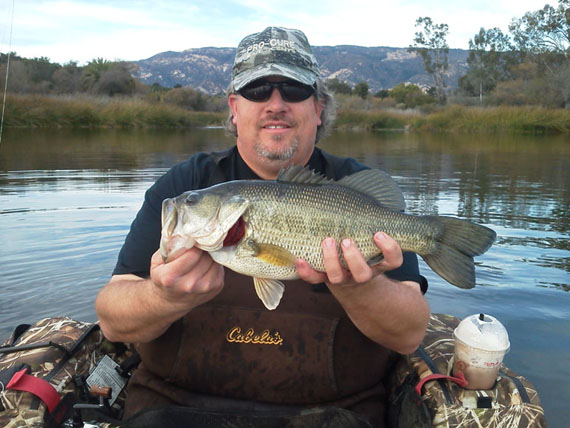
#400 - First catch -
December 15, 2013

#400 - Fifth Catch -
April 11, 2014
Female
weight loss after spawning:
Fish #480 was first
caught on February 13, 2014.
Quick trip fishing from shore after dropping Pierce at school. Absolutely
beautiful fish, thick and healthy at 17" and 3.28 lbs. Second catch was on
March 28, 2014 on the other
side of the lake near the dam. She had lost over a half a pound and was not quite as
perfect as the first catch. Some "battle damage" from the spawn. Third catch was
April 5, 2014 - she had
lost another 1/4 pound or so.
Female
weight loss after spawning:
#507 - On
February 14,
2014 my friend RJ caught and released a beautiful 17" bass. 12 days later I
caught her again in the same area. As soon as I saw the unique pyramid shaped
pattern just under her spiny dorsal fin on the left side I knew she was the same fish.
She was caught once more in June, again in the same area, and had lost almost
20% of her pre-spawn weight.
Fish Identification:
Fish #507 (above), #518 and #525 are three fish that were tagged the second time they were caught. Identified by scale pattern matching and bodily irregularities in photographs.
Fish #518 was a male sitting on a spawning bed caught on March 11, 2014 from shore during a quick stop on my way to work. Noticed the wound just above his anal fin. I remembered that Fred had sent me a picture of an un-tagged fish that had a wound from where he removed a leech. Sure enough it was the same fish. Tagged and release him and he immediately went back to sitting on his bed. About 10 minutes later there were three females in his bed with him. Two of them left relatively quickly but one was still there with him when I left. Took Pierce back to the lake after school. The females were gone but he was still on the bed. Both Pierce and I caught him again. Making him the second fish we caught three times in one day during the study.
#525 - Fred caught an un-tagged fish on February 22, 2014. A month later I caught it again. Later at home when examining pictures of un-tagged fish I noticed they were the same fish.
2014 Fish Kills:
Unfortunately, after two more Winters of below average rainfall the lake suffered a severe series of fish kills starting in June which put an end to the study: June 13 - July 11 - July 20 - August 4 - August 26
Diaries and Research: [2012-2014] [2011-2012] [Late 90s] [Early 90s] [The 80s]
(data website not designed for small screens - best viewed with a computer and monitor)


